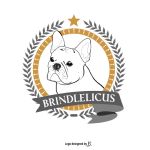Health Testing
DNA
French Bulldog Spine and Hip Scheme
Dr Karen Hedberg BVSc
In the French Bulldog we may face two significant structural bone problems – hemivertebrae and hip dysplasia.
Hemivertebrae – current breed median 14.00 (February 2022)
http://orchid.ankc.org.au/Home/SpineScores
These are vertebrae that have not developed properly and as a result of being misshapen, can result in instability of the vertebral column (the back). When the back is unstable, pinching of the spinal cord and disc protrusion can occur. Many brachycephalic and/or screw tail breeds have hemivertebrae, with French Bulldogs having a high incidence.
The average French Bulldog has a minimum of 3 hemivertebrae which was discovered in a major study in the USA. The majority of these hemivertebrae are within the thoracic area where extra stability is added by the rib cage.
The areas of concern in breeding animals are when hemi vertebrae occur within the lumbar area with no supporting frame and around the thoracolumbar junction (mid back at the end of the rib cage). Concern also when hemivertebrae are causing kyphosis or scoliosis.
The best way to view the back is with two views, one lateral from the shoulders to the tail, and the other in the anterior/posterior view i.e. of the dog on its back.
For assessing hemivertebrae, the scoring is as follows:-
- Grade 1 Partially wedged vertebra : score 1
- Grade 2 Fully wedged vertebra : score 2
- Grade 3 Double wedged (butterfly) vertebra : score 3
As we now have good numbers – the breed median is sitting at 14 – it is strongly recommended not to breed with backs scoring higher than 15, particularly if there are other issues such as a high hip score and/or a high respiratory function grade.
Hip dysplasia – current breed median 15 (February 2022)
http://orchid.ankc.org.au/Home/HipScores
Hip dysplasia can be a problem in the breed and we need to screen for this. The most common issues are shallow sockets and loose ligaments. The best view is an anterior/posterior view i.e. of the dog stretched out on its back with the legs parallel.
The breed average is at 17.77 with the median result at 15.0. This indicates the average is lowering slightly over time. Recommendations: Dogs with hip scores of over 20 be bred with caution unless they have an excellent low back score and a good respiratory function grade result.
Both x-rays can fit on a large plate with the screen divided along the long axis. Half the plate can be of the lateral view of the spine, the other half can be a vertical view of the hips and spine. Dogs should be screened over 12 months of age.
The two schemes should be considered simultaneously. Significant problems in both areas would be enough to suggest strongly that one should not breed with the animal.
Grading
A number of Veterinarians are now set up to grade your xrays and provide a score.
Forms are now created through the ORCHID database. Follow the instructions and the system will create a custom Word document which provides the Grading Form (with corresponding Vet Contact). You can then download the form and print it out to take to the nominated vet who can verify the Microchip number and perform the X-Ray for passing on to the DICOM Radiologist.
- Go to the ORCHID Form Creation Page by clicking here
- For further information and a list of Panelists click here
Fees $110.00 Hips and Spine
To lodge your grading forms go here orchid.ankc.au/Home/ChedHowTo
RFG
Details
Dogs Australia (DA) has licensed the "Respiratory Function Grading" (RFG) scheme from the UK Kennel Club (KC). DA operates and administers the RFG Scheme supported by the University of Cambridge who have approved the assessment protocol for the scheme. The aim of the scheme is to detect the presence and severity of brachycephalic obstructive airway syndrome using a clinical assessment and exercise tolerance test.
The objectives of the scheme are as follows;
- To identify dogs at risk/subject to BOAS to allow for the best care and treatment for managing such conditions l To give the breeder/owner the best available information in terms of the appropriateness of using a dam/sire in a breeding programme
- To give other breeders the information resource of dogs affected and unaffected by BOAS to allow for the selection of the most suitable stock for breeding purposes
- To provide data and statistics in terms of BOAS to monitor the frequency and progress in the breed affected for ongoing research for the overall improvement of the relevant breeds
Grade definitions;
Grade 0
Your dog is clinically unaffected and is currently free of respiratory signs of BOAS. If your dog is under 2 years old we suggest they have an annual health check with their own vet, as BOAS can develop later in life.
Grade 1
Your dog is clinically unaffected but does have mild respiratory signs linked to BOAS. These signs do not affect their exercise performance. If your dog is under 2 years old we suggest they have an annual health check with their own vet, as BOAS can develop later in life.
Grade 2
Your dog is clinically affected (moderate) and has moderate respiratory signs of BOAS that should be monitored and may require veterinary treatment.
Grade 3
Your dog is clinically affected (severe) and has severe respiratory signs of BOAS and should be seen by your own vet for a thorough veterinary examination with treatment. We do not recommend that you breed from your dog. For more details please email: [email protected]
